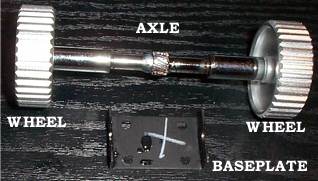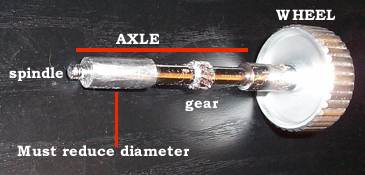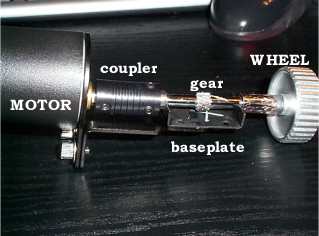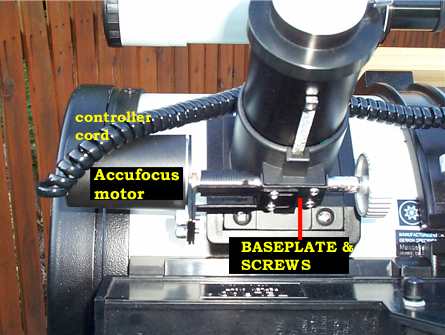YOU SHOULD BUY AN ORION ACCUFOCUS
The small cost is worth it.
The standard focuser that arrives with the LXD-75 SN-8 is not the best
part of the equipment. The focus wheels require a lot of torque (twist) to
turn them and this means that the scope will wobble around on its mount when you are
focusing. This small amount of wobble when you are looking through a telescope
translates into a whole lot of movement when you are looking at something magnified
through the telescope's eyepiece. No matter how gently you try no human hand will be
able to keep the stars in the field of view steady while turning, or even touching, the
focus wheels. To focus you must turn the focus wheel then take your hand off and
wait for the scope to stop vibrating. You then check to see if the stars are in
focus and then you try again and again, each time adjusting finer and finer until you
think you are in focus. This sucks. For astrophotography it is barely
acceptable.
I bought the Orion Accufocus to help overcome this problem and eliminate
the wobble and shake associated with attempting fine-focus by hand.
I'm very happy with this purchase. It didn't cost very much and it is a huge
improvement for focusing.
To fit the Orion Accufocus you need to remove one of the focus wheels. I would not
recommend trying to twist the wheel off while everything is still attached to the
telescope. I think it would have been far too easy for me to damage the focuser, something
in the focus tube (or everything) if I did that. It was far easier and safer to first
remove the focus wheels and the axle that joins them. This, I thought, was going to be the
trickiest part, but in the end it was easy.
What you do is remove the baseplate on the underside of the LXD-75 focuser. Four screws
hold the baseplate onto the focus tube.
The baseplate keeps the axle in its place. When you remove the baseplate's screws the
focus wheels and the axle that joins them just fall away. You end up holding in your hand
the axle with its two focus wheels at either end.

It's important not to forget which focus wheel you are going to remove
because the orientation of the wheels DOES MATTER when it comes time to put the axle back
in place. There is a worm gear in the centre of the axle and if you fit it back the wrong
way there'll be a problem. I recommend marking the wheel you want to remove with an
indelible pen so you know which witch is which. I decided to remove the focus wheel that
is closest to the corrector plate. This is so the motor is on that side and will not be
pressing up against the OTA tube rings.
To remove the focus wheel from the axle I used a pair of pliers. I gripped the axle firmly
with the pliers in my right hand and using my left hand turned the "left" focus
wheel with moderate force, and it unscrewed quite easily. It surprised me how easily it
screwed off.

With the LXD-75 SN-8 you MUST remove about 1 mm diameter from the focus
wheel axle so that it will fit inside the Accufocuser's flexible coupler. You will not be
able to fit it if you don't. 9 mm versus 8 mm. I thought this step would prove tricky but
by using a flat metal file and my pair of pliers I filed down the axle evenly until it was
the right diameter.
When you are filing you grip the axle and then file off a bit from the top side of the
axle, rotate the axle slightly and file the new topside a bit, then rotate and file,
rotate and file, etc, etc.. I worked up a mild sweat but it took only about 10 minutes to
finish the job - being careful. My only problem was that the grip of the pliers marked up
the axle quite a lot. It doesn't affect the performance, just the cosmetic look of the
axle. I should have put something where the pliers were, to protect the axle, but the
bloodlust was upon me and well, you know how it is...
|
Caution: If you do file down the axle to fit the Accufocus onto it, then
make sure you clean off all the metal filings before you put the axle back into your
scope. I added a small amount of Lithium grease to the axles central gear to replace what
was wiped off. |
Once you've reduced the diameter of the axle the flexible coupler can be
slid on, but don't tighten the hex screws at this time.
The little threaded spindle on which the old focus wheel was screwed can
be left as is and you don't have to cut it off, but if you do you will be able to push the
flexible coupler further onto the axle.

At this point with a little care I was able to pick everything up,
including the motor assembly, and install it back onto the telescope. The four Phillips
head screws on the baseplate were adjusted so they were just touching the baseplate. While
you are lining up the Accufocus the baseplate should be ever so slightly loose. While
loose, align the Accufocus so it is straight and square and then tighten up the Phillips
screws on the baseplate, this time making them 'finger tight' on the baseplate.
The hex screws on the Accufocus' flexible coupler should be tighter. The torque that the
little motor generates is considerable.
DO NOT overtighten the Phillips screws on the focuser baseplate because if you do the
Accufocus may not work because of the pressure of the baseplate metal pressing onto the
axle. I did this (overtightened) and thought that the Accufocus was a dud, and that it
wasn't working. Curses ensued while I changed the battery before I figured out that the
problem was that I was strangling the thing. Loosening the Phillips screws on the
baseplate so they were "finger tight" did the trick. The axle was able to move
freely.

There it was. It worked. The focuser was moving in and out.
The first test that I did was to look through a 26mm Super Plossl at M42
(the Orion Nebula). When I changed the focuser motor's direction I was disappointed to see
that the image swung backwards and forwards quite a lot (about 20 arcseconds with the 26mm
Plossl). Changing the motor's direction induces the SN-8's focus tube to move. You can
reduce the effect of this by tightening the focus tube's locking screw to the point where
it just catches (and thus provides additional support) while still allowing the focus tube
to move in and out.
If you advance the motor in one direction towards the focus point then the image holds
very still and you can "step" up to the focus point at the speed that suits you:
the image will come into focus. If you overshoot and have to change direction it's then
that your target will move quite a bit within your field of view. Annoying but not overly
so. Just change direction and slowly step up to the focus point again.
Once you install the Accufocus you cannot adjust your focus manually. For very major focus
adjustments (like changing cameras) You can help the motor along and speed things up, very
slightly, by helping the motor to rotate the focus wheel (if you do this then do it
gently!).
The motor is not a stepper motor but by using quick presses on the buttons you quickly get
a feel for how much of a "step" each press is. Actually the analog nature of the
controller will be something of an advantage for me once I get familiar with using it.
Long story short, the Orion Accufocus is, by far and away, a LOT better than focusing by
hand. The difference is chalk and cheese.
If you have the stock standard LXD-75 focuser then buy one. Today.
After my Telrad and the Televue Powermate (x4) the Orion
Accufocus is the most useful "accessory" that I've purchased.
For visual use it is great. Testing it out with a Mintron video camera at prime focus with
an Orion ShortyPlus Barlow (total weight about 460g) it works wonders. With a fresh
battery it lifted that weight no problem at all. I watched on TV while I stepped gradually
up to the focus point with very little image shift with each click on the controller.
Within one minute the core of the Orion nebula was in focus - as good as ever I've ever
been able to judge it on TV. Changing the direction of the motor moves the image around a
lot as I've already said, but you can easily use the Autostar in one hand, to keep things
centred, and use the focus controller in the other hand.
Estimating the exact focus point itself is still a subjective assessment, a motorised
focuser isn't going to help you with that.
Unless you use a knife-edge focuser you'll still not be able to tell when you're EXACTLY
in focus, however the Acccufocus will let you do the focusing without having all that
wobble associated with focusing by hand. You'll be able to step up to the focus point in
small 'predictable' steps. Using a Hartmann mask for focus adjustment becomes even easier.
I like using the Orion Accufocus in the LXD-75 SN-8. You may like it too.
<<<Back to Equipment
|




